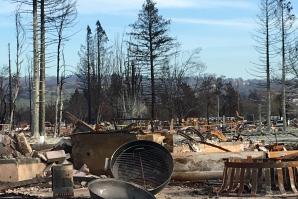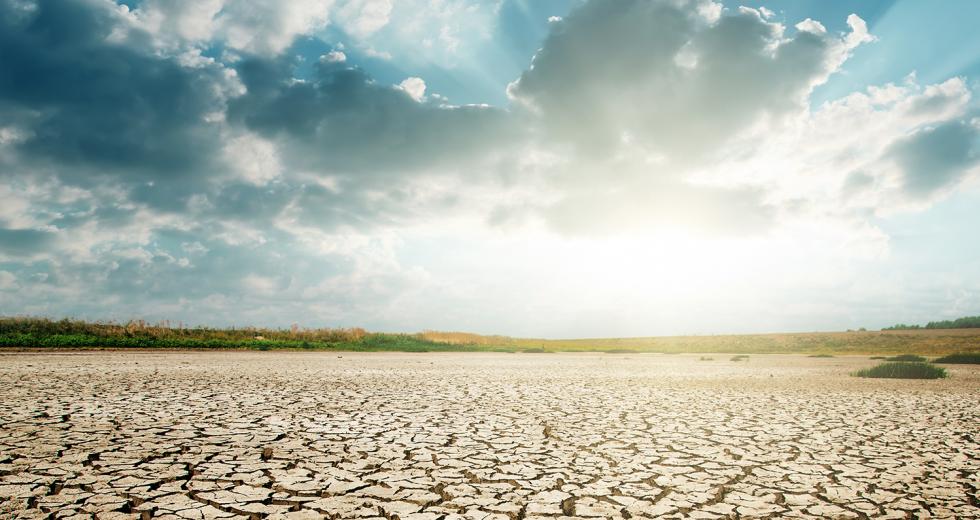California’s recent drought was the state’s worst in centuries, scientists have said. It began in December 2011, and lasted more than five years, killed or mortally injured more than 100 million trees, exacerbated the state’s groundwater deficit and pushed fish species toward extinction.
Then came torrential rains that made the early months of 2017 one of the wettest winters on record, producing torrents that nearly destroyed Oroville Dam’s spillway system and blanketing the Sierra Nevada with an unusually heavy snowpack. Quickly, the weather turned, and by July the state was broiling through the hottest summer in California’s history, and, by late fall, California had been scorched by two unprecedented heatwaves and several devastating flurries of wildfires, including the North Bay infernos. More recently, a storm in May 2019 produced record daily rainfall in many locations. One month later came a record-torching heatwave.
Mediterranean climates, like California’s, typically follow boom and bust cycles, marked by a predictable shift between cold and wet and hot and dry. But the changing climate will amplify that pattern with “wetter wets, drier dries and hotter hots,” warns Jeffrey Mount, a senior fellow at the water policy center of the Public Policy Institute of California and a professor emeritus at UC Davis.
Precipitation, he explains, will fall in faster, more furious fits over a briefer window of time before the rapid onset of longer, brutally hot summers. Warmer average temperatures will mean less snowpack, a key storage supply. “This will compress the window where we get our rainfall,” Mount says. “We already have a short winter.” Climate models, Mount says, indicate that average annual rainfall may remain steady even in a much warmer future. However, because that rain might fall in larger and fewer storms in a shorter amount of time, “It means we can’t store it all, and we have to let some of it flow downstream toward the ocean.”
“That means a net loss,” Mount says, explaining that when water is needed most — the summer and early fall — much of the year’s precipitation will have already been released to the sea.
The state’s recent extreme weather events are just a preview of what’s to come in the next few decades, warn local scientists, who say global warming will drive an unnerving climate roller coaster that will kill thousands of Californians, destroy cropland, wipe out species, cause billions in damages and force fast-thinking innovation among officials who manage California’s water supply.
How to Save More of Our Water
Building more dams is not likely in the cards. One notable project, the proposed Sites Reservoir in Colusa County, is advancing in the planning stages and could eventually store 500,000 acre-feet of diverted Sacramento River water. For the most part, though, dams will be looked upon as clunky features of the 20th century.
Lawmakers and policy analysts are looking ahead, and they see a variety of possibilities for mitigating the impacts of climate change. The City of Sacramento along with the Placer and Sacramento county water agencies, which rely mostly on water from the American River, have a tentative plan to tap into the Sacramento River during times of surplus flow. The project, called RiverArc, would also integrate groundwater into the new pipelines but remains in the planning stages as agencies seek funding.
Statewide, the most popular idea for protecting water supply is making better use of underground storage. Geologists believe the volume of aquifer capacity is several times that of all the state’s reservoirs combined, especially after years of aggressive pumping in recent dry years. “The overdraft of groundwater that we caused during the drought has actually created an opportunity for storage,” says Heather Cooley, director of research at the Pacific Institute, an Oakland think tank geared toward water policy.
California passed a groundbreaking law in 2014 aimed at stabilizing and recharging depleted aquifers, though the Sustainable Groundwater Management Act might not produce significant results for 20 more years. But already, water agencies, environmental organizations and landowners are taking action to put water underground. To do this, water must be slowed down, allowed to spread over a wide area of porous earth and given the time it needs to sink downward. The storage space is free, but there are logistical barriers, most of all finding the land. “It takes a lot of land to sink that water,” says John Andrew, the director of the California Department of Water Resources’ climate change team.
Fortunately, land can be essentially borrowed from farmers, and the state is collaborating on various environmental nonprofits to modify levees — generally by cutting large notches into them — so rivers, like the Sacramento, may flood in the winter months across thousands of acres of historic floodplains, like the Sutter and Yolo bypass areas, that were separated from the main river channel by levees in the 20th century. During its time on a floodplain, water can percolate into the ground. Later in the year, the same land can be used for farming row crops and rice.
Floodplains also are considered one of the major missing habitat links essential for reviving California’s depleted salmon runs, and the reason California Trout, Trout Unlimited and the Golden Gate Salmon Association are pushing for various floodplain projects.
Biologist Peter Moyle, a professor emeritus at UC Davis, co-authored a 2017 report predicting that most of California’s native salmon and trout would eventually vanish, due to habitat loss, insufficient spawning conditions and the effects of climate change. “California’s salmon are very well adapted to extreme events,” he says, but even the hardy Chinook salmon, the focus of a $1.4 billion fishing industry, has been pushed to the brink, and climate change is emerging as a major adversary to what was once a primary source of food and natural wealth for many indigenous Californians.
Moyle says maintaining river flows at or above current levels will be critical to prevent salmon extinction. “California has pretty much reached the limits to how much water it can divert if we care about having fish,” he says.
Moyle says communities and industries must “do a better job of water conservation.” He also says thousands of acres of farmland must be removed from active production. “Irrigating the present acreage requires more surface water than is available, resulting in massive pumping of groundwater, which is being depleted faster than it can be recharged,” he says.
Forcing farmers to fallow land is not a likely option, but Mount believes market forces will drive this change. As water for farming becomes more costly, certain crops, especially in regions where water must be purchased, may become unprofitable to grow. Mount says a recent PPIC analysis found that once the cost of water for irrigation reaches $400 to $500 per acre-foot, farming is no longer a profitable endeavor. When desperate to keep their trees alive, some farmers may pay as much as $2,000 per acre-foot, Mount says, but many farmers in the Central Valley can’t afford a long-term rate higher than $200 per acre-foot. The PPIC has also estimated that the state’s new groundwater rules, by curbing unlimited pumping, could result in the fallowing of half a million acres of irrigated farmland.
Too Many Water-Intensive Crops
The farmers most likely to throw in the towel first are those in the western San Joaquin Valley — in the lightly populated region along Interstate 5 — where growers depend on imported water for which they must pay. That farmers are growing such water-intensive crops in such arid places is the result of misguided 20th century engineering, says Jon Rosenfield, a senior scientist with Baykeeper, an environmental watchdog group in Oakland. Rosenfield says dams and other storage and conveyance infrastructure created an illusion of water security and reliability. “We’ve tried to impose predictability on a system that’s inherently very variable,” he says.
This false promise of a steady water supply has led to the overplanting of water-intensive crops, especially nuts and other tree fruits that require water every year. “There’s no way we should be growing so many tree crops in a climate that’s so unpredictable,” Rosenfield says. “But our current policy encourages that kind of risk-taking.”
Over the past 20 years, the almond industry has grown, and grown and grown. In 1995, almond orchards covered less than 500,000 acres in California. Today, they occupy almost 1.4 million acres, and the rate of growth is not slowing. This has drawn criticism from other users, who say the almond industry has created a significant strain on shared water supplies.
Because they must be watered almost constantly — even after producing plants are mature — grapes, nuts and other tree crops are partially responsible for a loss of flexibility in how water is managed in California. But Richard Waycott, CEO of the Almond Board of California, says his industry’s farmers are trying to produce food with a minimum of impacts. “The hope is to strike a balance between urban needs, the environment and agriculture,” he says.
Almond farmers have reduced the amount of water it takes to grow each almond by 33 percent in the last 20 years, he says, and the industry aims to increase those savings to 50 percent by 2025. Moreover, almond farmers, who produced $5.6 billion in nuts in 2017, according to state crop records, have donated $100,000 to the UC Davis Center for Watershed Sciences for floodplain restoration projects, Waycott says.
The authors of a paper published last year in the journal Agronomy addressed the risks of investing in trees and grapevines in a time of rapid climate change. “Permanent crops are among the most profitable commodities in California,” the authors, led by scientists from UC Merced and UC Davis, wrote. “They are most commonly grown for more than 25 years, which makes them more vulnerable to impacts of climate change.”
Andrew, of the Department of Water Resources, defends almond farmers, explaining they have been pragmatic by growing whatever is most profitable. “They invested in these orchards that make more money for the amount of water they apply,” he says. “Of course, the tradeoff is, with these annual crops, if you got into a drought, you could just not plant them, but with almonds and grapes, you have to keep the water coming.”
Climate Change Predictions Are Dire
California’s 2018 Climate Change Assessment report predicted a long drought could cost the state $3 billion and that Californians will eventually be paying $200 million per year in increased energy bills, mainly for air conditioning, as temperatures rise. The report also warned that stifling heat waves could cause 11,000 heat-related fatalities statewide each year by 2050. That’s three times California’s current annual death toll from motor vehicle accidents.
And the Agronomy paper warned that extreme weather events, including heat waves, floods and droughts, and a shift toward warmer winters and earlier springs, would affect California’s agricultural production, worth about $50 billion.
Snowpack, which historically has contained and slowly released through the summer months 80 percent of California’s precipitation, could shrink by an average of 65 percent. More rapid melting of snow “causes reservoirs to fill up earlier, increasing the odds of both winter flooding and summer water deficits,” warned the Agronomy paper authors.
They found that yields of wine grapes, strawberries, walnuts, almonds and cherries, among other important crops, are likely to decline, and by mid-century “virtually no areas will remain suitable” in the Central Valley for the production of pears, apples and cherries. These and other impacts, they added, will hit at a time when the growing human population and shifting diets require a doubling of crop yields by 2050.
In anticipation of climate-related impacts to water supply, Gov. Gavin Newsom issued an executive order in April calling on state agencies to create a Water Resilience Portfolio, essentially a plan for building a more resilient system for storing and distributing water while maintaining healthy river ecosystems. The Natural Resources Agency, California Environmental Protection Agency and Department of Food and Agriculture are expected to produce this portfolio by the end of the year.
—
Discuss this story and others on our Facebook page; “like” Comstock’s on Facebook by clicking or tapping here.
Recommended For You

Climate Change Is Going to Cost California, and the Bill Will Be Staggering
As California lawmakers struggled this week to address an apparent new normal of epic wildfires, there was an inescapable subtext: Climate change is going to be staggeringly expensive, and virtually every Californian is going to have to pay for it.

Meat, Water and Global Warming
Despite environmental impacts of livestock, restaurants aren’t giving up their meat
According to some ecologists and experts on global agricultural trends, our eating habits must change dramatically if we are to overcome environmental issues facing the planet and its future generations.



